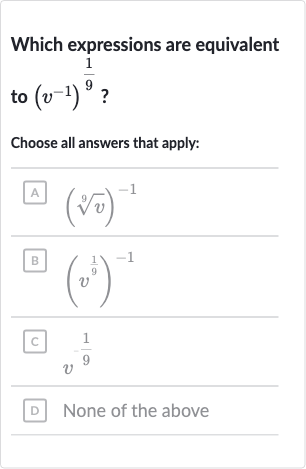Full solution
Q. Which expressions are equivalent to ?Choose all answers that apply:A B C D None of the above
- Understanding exponent properties: Understand the properties of exponents that will be used to solve the problem.The properties of exponents that are relevant here are: - Raising a power to a power means you multiply the exponents. - A negative exponent means that the base is on the opposite side of the fraction line.
- Applying exponent property to given expression: Apply the exponent property to the given expression . Using the property , we get:
- Comparing the result: Compare the result from Step with the given choices.We found that simplifies to .Now we need to check which of the given choices are equivalent to this expression.
- Evaluating choice A: Evaluate choice A: . The expression is equivalent to because the th root of is raised to the power. Using the property , we get: This matches the expression we found in Step .
- Evaluating choice B: Evaluate choice B: . This is the same expression we evaluated in Step , and we have already determined that it is equivalent to .
- Evaluating choice C: Evaluate choice C: . This is exactly the expression we derived in Step , so it is clearly equivalent to .
- Evaluating choice D: Evaluate choice D: None of the above.Since we have already found that choices A, B, and C are equivalent to the original expression, choice D is not correct.
More problems from Compare linear and exponential growth
QuestionGet tutor help
QuestionGet tutor help
QuestionGet tutor help
QuestionGet tutor help
QuestionGet tutor help
QuestionGet tutor help
QuestionGet tutor help

